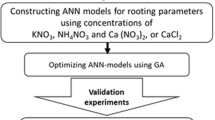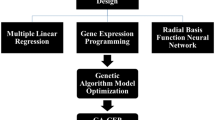Abstract
Key message
ANN-based combinatorial model is proposed and its efficiency is assessed for the prediction of optimal culture conditions to achieve maximum productivity in a bioprocess in terms of high biomass.
Abstract
A neural network approach is utilized in combination with Hidden Markov concept to assess the optimal values of different environmental factors that result in maximum biomass productivity of cultured tissues after definite culture duration. Five hidden Markov models (HMMs) were derived for five test culture conditions, i.e. pH of liquid growth medium, volume of medium per culture vessel, sucrose concentration (%w/v) in growth medium, nitrate concentration (g/l) in the medium and finally the density of initial inoculum (g fresh weight) per culture vessel and their corresponding fresh weight biomass. The artificial neural network (ANN) model was represented as the function of these five Markov models, and the overall simulation of fresh weight biomass was done with this combinatorial ANN–HMM. The empirical results of Rauwolfia serpentina hairy roots were taken as model and compared with simulated results obtained from pure ANN and ANN–HMMs. The stochastic testing and Cronbach’s α-value of pure and combinatorial model revealed more internal consistency and skewed character (0.4635) in histogram of ANN–HMM compared to pure ANN (0.3804). The simulated results for optimal conditions of maximum fresh weight production obtained from ANN–HMM and ANN model closely resemble the experimentally optimized culture conditions based on which highest fresh weight was obtained. However, only 2.99 % deviation from the experimental values could be observed in the values obtained from combinatorial model when compared to the pure ANN model (5.44 %). This comparison showed 45 % better potential of combinatorial model for the prediction of optimal culture conditions for the best growth of hairy root cultures.





Similar content being viewed by others
References
Brady SM, Provart NJ (2009) Web-queryable large-scale data sets for hypothesis generation in plant biology. Plant Cell 21:1034–1051
Coruzzi GM, Burga AR, Katari MS, Gutiérrez RA (2009) Systems biology: principles and applications in plant research. In: Gloria M, Coruzzi GM, Rodrigo AG (eds) Annual plant reviews, plant systems biology, vol 35. Wiley, New York, pp 3–40
Eddy SR (2004) What is hidden Markov model? Nature Biotechnol 22:1315–1316
Gago J, Landín M, Gallego PP (2010a) Strengths of artificial neural networks in modeling complex plant processes. Plant Signal Behav 5:743–745
Gago J, Landín M, Gallego PP (2010b) A neuro fuzzy logic approach for modeling plant processes: a practical case of in vitro direct rooting and acclimatization of Vitis vinifera L. Plant Sci 179:241–249
Georgiev MI, Pavlov AI, Bley T (2007) Hairy root type plant in vitro systems as sources of bioactive substances. Appl Microbiol Biotechnol 74:1175–1185
Giri A, Narasu LM (2000) Transgenic hairy roots: recent trends and applications. Biotechnol Adv 18:1–22
Goel MK, Goel S, Banerjee S, Shanker K, Kukreja AK (2010) Agrobacterium rhizogenes-mediated transformed roots of Rauwolfia serpentina for reserpine biosynthesis. Med Arom Plant Sci Biotechnol, pp 8–14
Guillon S, Trémouillaux-Guiller J, Pati PK, Rideau M, Gantet P (2006) Hairy root research: recent scenario and exciting prospects. Curr Opin Plant Biol 9:341–346
Haider MA, Pakshirajan K, Singh A, Chaudhry S (2008) Artificial neural network-genetic algorithm approach to optimize media constituents for enhancing lipase production by a soil microorganism. Appl Biochem Biotechnol 144:225–235
Huang SY, Chou SN (2006) Elucidation of the effects of nitrogen source on proliferation of transformed hairy roots and secondary metabolite productivity in a mist trickling reactor by redox potential measurement. Enzyme Microb Tech 38:803–813
Karim MN, Yoshida T, Rivera SL, Saucedo V, Eikens B, Oh G (1997) Global and local neural network models in biotechnology: application to different cultivation processes. J Ferment Bioeng 83:1–11
Kim Y, Wyslouzil BE, Weathers PJ (2002) Secondary metabolism of hairy root cultures in bioreactors. In Vitro Cell Dev Biol Plant 38:1–10
Liu G, Jiang X, Mei C (2010) Soft-sensing modeling method based on continuous hidden markov model for microbial fermentation process. In: Chinese Control and Decision Conference IEEE, pp 1106–1110
Mehrotra S, Prakash O, Mishra BN, Dwevedi B (2008) Efficiency of neural networks for prediction of in vitro culture conditions and inoculum properties for optimum productivity. Plant Cell Tissue Org Cult 95:29–35
Mishra BN, Ranjan R (2008) Growth of hairy-root cultures in various bioreactors for the production of secondary metabolites. Biotechnol Appl Biochem 49:1–10
Nayak R, Gomes J (2009) Sequential adaptive networks: an ensemble of neural networks for feed forward control of l-methionine production. Chem Eng Sci 64:2401–2412
Ono NN, Tian L (2011) The multiplicity of hairy root cultures: prolific possibilities. Plant Sci 180:439–446
Prakash O, Mehrotra S, Krishna A, Mishra BN (2010) A neural network approach for the prediction of in vitro culture parameters for maximum biomass yields in hairy root cultures. J Theor Boil 265:570–585
Prasad VSS, Dutta Gupta S (2008) Applications and potentials of artificial neural networks in plant tissue culture. In: Dutta Gupta S, Ibaraki Y (eds) Plant tissue culture engineering. Springer, Berlin, pp 47–67
Singh V, Khan M, Khan S, Tripathi CKM (2009) Optimization of actinomycin V production by Streptomyces triostinicus using artificial neural network and genetic algorithm. Appl Microbiol Biotechnol 82:379–385
Taya M, Yakura K, Kino-oka M, Tone S (1994) Influence of medium constituents on enhancement of pigment production by batch culture of red beet hairy roots. J Ferment Bioeng 77:215–217
Yu S, Kwok KH, Doran PM (1996) Effect of sucrose, exogenous product concentration, and other culture conditions on growth and steroidal alkaloid production by Solanum aviculare hairy roots. Enzyme Microb Tech 18:238–243
Acknowledgments
The financial support provided by Department of Science and Technology, Government of India to author Shakti Mehrotra and Council of Scientific and Industrial Research (CSIR) to Om Prakash is gratefully acknowledged. We are also grateful to Director, CSIR-CIMAP for providing facilities and support.
Author information
Authors and Affiliations
Corresponding author
Additional information
Communicated by J. R. Liu.
Rights and permissions
About this article
Cite this article
Mehrotra, S., Prakash, O., Khan, F. et al. Efficiency of neural network-based combinatorial model predicting optimal culture conditions for maximum biomass yields in hairy root cultures. Plant Cell Rep 32, 309–317 (2013). https://doi.org/10.1007/s00299-012-1364-3
Received:
Revised:
Accepted:
Published:
Issue Date:
DOI: https://doi.org/10.1007/s00299-012-1364-3




